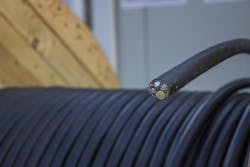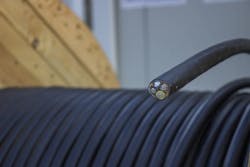Tip of the Week: The Value of Insulation Resistance Testing
Insulation resistance testing is one of the most useful predictive maintenance tests available. This test gives insight into the integrity of insulation. The higher the resistance across the insulation, the less current is escaping through it. Conversely, a low reading means that insulation is leaking.
An obviously low resistance (e.g., 500 ohms instead of 150 megohms) indicates a bad cable or motor winding. Performing insulation resistance testing during or immediately following installation will enable you to identify insulation failures so they can be corrected (replace the cable or motor) prior to energization. That’s an obvious benefit of this testing. But if you’re installing new cables and new motors, why bother?
One reason is that cables sometimes do get damaged during installation. You want to catch this as early as possible. A more important reason is that testing at this juncture is the only way to get the baseline data you need for maintenance trending.
The insulation resistance test really proves its worth when used over time rather than as a single go no-go condition test. If you have baseline data and perform subsequent insulation resistance tests at set intervals using the same test voltage, you can plot the results.
Many tools exist for tracking and plotting insulation resistance testing results. You can even make your own by using a spreadsheet. Now imagine you’re looking at a chart of a series of insulation resistance test measurements for a particular cable, and each measurement is a plot point on that chart. The vertical axis is the resistance value and the horizontal axis is time. You’ll notice a line drawn from each point gradually trends downward over time.
This downward slope is very slight. What you’re looking for is a “break” in that line, where the slope suddenly is steeper than normal. When you see this, you know the deterioration of that insulation has accelerated beyond the normal rate.
Depending upon the rate of acceleration, you may decide to do any of several things, such as:
• Add the cable to the list of cable to be replaced during the next shutdown.
• Increase the test frequency to monitor the problem more closely.
• Replace the cable (or motor) as soon as the work can be scheduled.
Note that the value obtained to create the break in the trendline could easily be within an acceptable range. That is, the insulation resistance isn’t low on an absolute scale. It’s low relative to the previous set of readings.
About the Author

Mark Lamendola
Mark is an expert in maintenance management, having racked up an impressive track record during his time working in the field. He also has extensive knowledge of, and practical expertise with, the National Electrical Code (NEC). Through his consulting business, he provides articles and training materials on electrical topics, specializing in making difficult subjects easy to understand and focusing on the practical aspects of electrical work.
Prior to starting his own business, Mark served as the Technical Editor on EC&M for six years, worked three years in nuclear maintenance, six years as a contract project engineer/project manager, three years as a systems engineer, and three years in plant maintenance management.
Mark earned an AAS degree from Rock Valley College, a BSEET from Columbia Pacific University, and an MBA from Lake Erie College. He’s also completed several related certifications over the years and even was formerly licensed as a Master Electrician. He is a Senior Member of the IEEE and past Chairman of the Kansas City Chapters of both the IEEE and the IEEE Computer Society. Mark also served as the program director for, a board member of, and webmaster of, the Midwest Chapter of the 7x24 Exchange. He has also held memberships with the following organizations: NETA, NFPA, International Association of Webmasters, and Institute of Certified Professional Managers.

